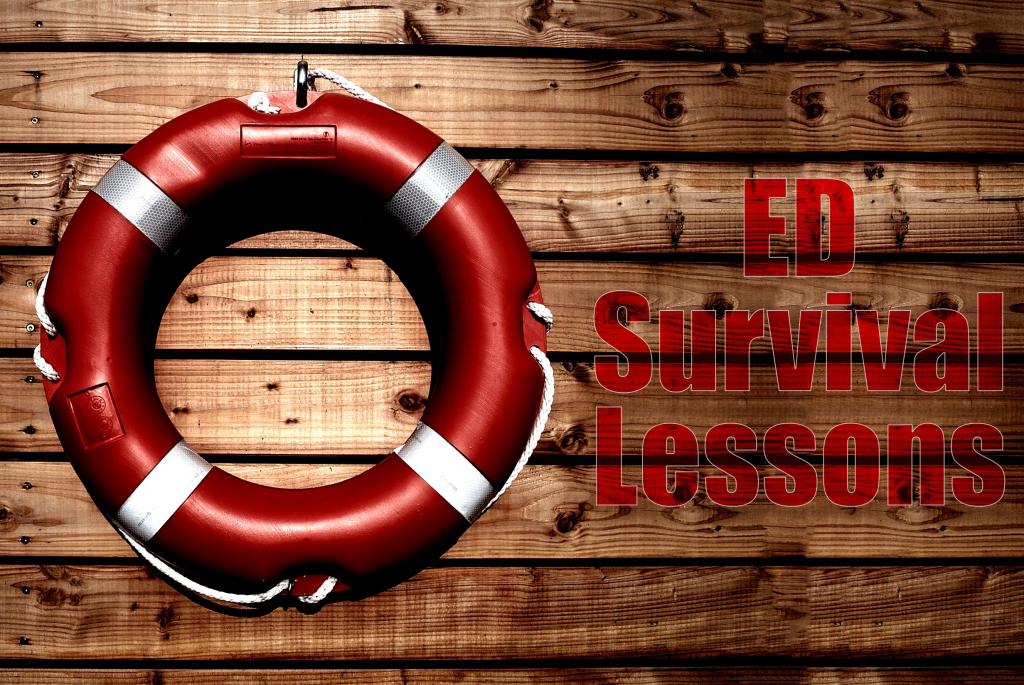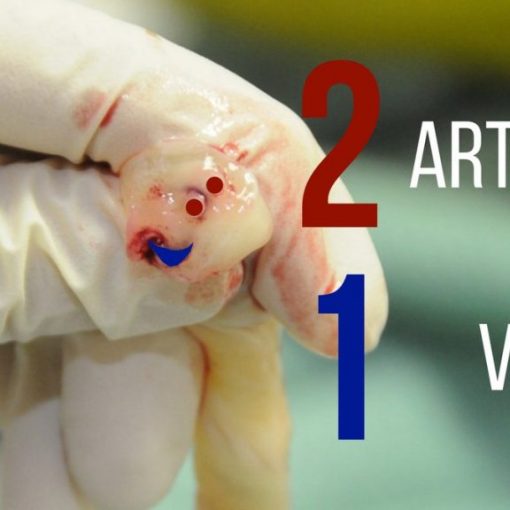
“Deep Survival: Who Lives, Who Dies, and Why” by Laurence Gonzales is a book about life and death. It explores disasters – at the top of mountains, in the middle the ocean, in the most remote wilderness – and examines why some people live while others die. Gonzales concludes with book with some advice designed to help readers survive. As I read his advice, I was struck by how applicable it is to the practice of emergency medicine. These are his survival lessons, adapted for the ED:
1) Take the training that’s available
Gonzales is talking about the kind survival training where they dump you in the wilderness with nothing but a butter knife, but the same advice clearly applies in emergency medicine. We must be lifelong learners. Going into the uncharted territory of a difficult airway without ever having attended one of the many outstanding airway courses is silly and potentially deadly. Just like survival training, there is little value in obtaining this education after the fact. We have to be prepared for any eventuality. Training is available; we must use it.
2) Perceive, believe, then act
People who die in the wilderness frequently fail to properly observe their surroundings and orient themselves to their new environment before acting. “Perceive, believe and then act” sounds like a modification of the OODA loop (observe, orient, decide, act) that Scott Weingart has made famous in emergency medicine. The central tenet to both of these systems is that we often fail to change our perspective when circumstances shift in front of us. Instead, we continue to try to see the world as it was or as we think it should be. In the wilderness this leads to death. In the resuscitation bay, this leads to misdiagnosis and incorrect management. Expert level resuscitation requires constant re-orientation as the situation evolves.
3) Avoid impulse behavior; don’t hurry
The best resuscitationists I have ever watched have all been calm, quiet, and surprisingly slow in their actions. Things get done – rapidly – but no one is ever rushed. Gonzales points out that “catecholamines are a double-edged sword. They provide power when you need a burst of energy… But they can also make you so excited that you do the wrong thing.” As we step into the resuscitation bay, we are all hit with a surge of catecholamines. We are ready for action. We want to do something. As a result, there is a tendency to rush towards the more physical procedural tasks. However, we can become overly task-focused and lose situational awareness. Starting every resuscitation with a some deep breaths and a few moments of dedicated thought about the differential diagnosis and initial priorities can make those actions more efficient and prevent tunnel vision.
4) Know your stuff
People die because they don’t understand the environment they are heading into. They don’t understand how you can be pulled under water in rapids or how quickly the weather can change on a mountain. One key to survival is starting with an understanding of the forces you are dealing with. It isn’t hard to see the application to emergency medicine. If you are intubating without a clear understanding of the physiologic impacts of RSI in the patient in shock, you are on the path to disaster. We must know our stuff. (This is basically the whole point of the First10EM resuscitation plans.)
5) Get the information
Every year dozens of tourists drown in Hawaii. It’s not because they can’t swim, but because they don’t understand how treacherous the local conditions can be. Sadly, there are local experts (lifeguards) who are always happy to provide this information, if asked. Understanding local conditions is also essential in emergency medicine. When I started, I did locums at a number of different hospitals. Each had different equipment, all stored in different locations. I was constantly reliant on nurses to find things for me. If I needed to put in a chest tube, I would wander the room looking for a scalpel. It was inefficient and I looked like an idiot. It doesn’t matter how long you have been doing this job, or how great a doctor you are, if you are working in an unfamiliar environment you need to take the time to familiarize yourself with the surroundings. You need to know what equipment is available and where it is stored. You need to know your specialists. You need to know the protocols for STEMIs, strokes, and trauma. When starting somewhere new, come in early, and give yourself a few hours to get the information.
6) Commune with the dead
No, this is not about peyote induced hallucinations. Gonzales is talking about learning from those who have gone before you. Other people have made mistakes and died; you should learn from them. (I would add that others have also survived, and we need to learn from them as well.) Of course, we have our morbidity and mortality rounds in medicine, but in my experience, these are largely ineffective. Doctors still generally believe we should be perfect. A culture of shame (and legal issues) leads to highly selected cases being only superficially discussed at M&M rounds. Furthermore, M&M is a local process, which allows similar mistakes to continue at different hospitals across the country and around the world. We need to get far more comfortable routinely dissecting bad outcomes (and also bad situations that somehow become good outcomes.) We need to learn from our dead.
7) Be humble
This is an easy trap to fall into. A series of successes can given the impression of mastery. Emergency medicine is far too complex for anyone to truly master. There will always be knowledge gaps. Everyone will make mistakes. Knowledge gaps and mistakes are only a problem if you fail to recognize them. Humility is key. (See related post: Not Knowing)
8) When in doubt, bail out
At first glance, it seems like this advice doesn’t apply to emergency medicine. Gonzales is talking about trusting your gut. If you are planning a mountain expedition, but the weather doesn’t seem quite right, just don’t do it. Survive to try again another day. Unfortunately, in emergency medicine, we don’t start at the base of the mountain with trail maps and weather reports. We are blindfolded and dumped at the top of the trail in a blizzard when our shift begins. There is no backing out.
However, I do think there is an important lesson to be learned here. Although we can’t make the sick patient disappear, we can always stop what we are doing. A classic emergency medicine mistake is persisting in a management plan that isn’t producing results. If 2 litres of fluid didn’t correct the hypotension, we try a third. Although the first 2 attempts at direct laryngoscopy failed, we think we might get it on a third attempt. If the plan isn’t working – if you are in doubt – bail out. Start pressors instead of adding more fluids. Put in an LMA instead of that third look. If a resuscitation is not proceeding as expected, bail out: dump your preconceptions and restart your assessment from the start.
9) You have to have a positive mental attitude
We work in chaos. Our job is to see people on the worst day of their life. You simply can’t survive in emergency medicine without a positive mental attitude. A positive mental attitude reminds you why you are at work; why you are seeing your 10th nonspecific abdominal pain of the day. You might not make a diagnosis, but at least you can reassure and relieve pain. A positive mental attitude allows you to focus not on the 95% of cardiac arrest patients who remain dead, but on the 5% that survive. Amal Mattu would tell you “be a Tigger not and Eeyore”. Set the mood for the department. You need to your team to survive, and your team will be better if you inspire them. A positive mental attitude won’t just appear when you need it. Cultivate it. Focus on the good. Don’t voice the negative. Emergency medicine is fun – remember that.
Those 9 lessons would be enough on their own, but Gonzales goes on to list 12 key points that he believes distinguishes survivors from those who die. I think these all have important applications in emergency medicine:
- Perceive, believe (look, see, believe)
- Stay calm (use humor, use fear to focus)
- Think/analyze/plan (get organized; set up small, manageable tasks)
- Take correct, decisive action (be bold and cautious while carrying out tasks)
- Celebrate your successes (take joy in completing tasks)
- Count your blessings (be grateful – you’re alive)
- Play (sing, play mind games, recite poetry, count anything, do mathematical problems in your head)
- See the beauty (remember: it’s a vision quest)
- Believe that you will succeed (develop a deep conviction that you’ll live)
- Surrender (let go of your fear of dying; “put away the pain”)
- Do whatever is necessary (be determined; have the will and the skill)
- Never give up (let nothing break your spirit)
These final 12 points echo a lot of the point covered in the post “Performance Under Pressure.”
Thanks to Mike Mallin (@ultrasoundpod) for suggesting this book. He talks about it in his amazing talk “The day I didn’t use ultrasound“.


Morgenstern, J. Survival lessons for emergency medicine, First10EM, April 17, 2016. Available at:
https://doi.org/10.51684/FIRS.1921





